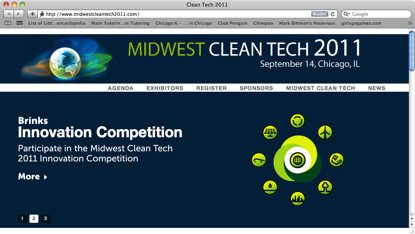Green-tech entrepreneurs, like most other start-up folks, probably spend more time worrying about securing their next round of financing compared with, say, intellectual property protection. But they ignore it at their peril.
So says Jim Naughton, chairman of the green technology practice group at Chicago intellectual property (IP) law firm Brinks Hofer Gilson & Lione. He works to draw both small and large green companies to the firm’s client roster. As more entrepreneurs race to take new clean-tech ideas from the lab bench to commercialization, it’s critical to make sure their ideas are protected from being copied by others, Mr. Naughton warns.
Since launching this new practice within the firm three years ago, the client list has grown, says Mr. Naughton, though he declines to say by how much. The growth of investment funds turning their attention to renewable energy start-ups and other emerging green-tech companies in the Midwest has inspired local entrepreneurs to consider the sector, Mr. Naughton contends. He also points to creation of the non-profit Clean Energy Trust, and the Illinois Innovation Council created earlier this year by Gov. Pat Quinn as good resources available to assist green entrepreneurs.
What’s missing locally, argues Mr. Naughton, is a coordinated effort to put the players together so they can speak to one another.
To address that deficiency and generate more networking opportunities for this sector, Brinks Hofer, the non-profit Global Midwest Alliance, and the Midwest Research University Network this week hosted the fourth annual Midwest Clean Tech conference.
The day-long gathering at the Federal Reserve Bank of Chicago included about 300 U.S. and international investors, entrepreneurs, and other business professionals. They learned about regional, as well as global, issues impacting the clean tech segment of the economy. A highlight of the meeting was a finalist round of a clean tech start-up competition sponsored by Brinks Hofer.
Five emerging clean-tech companies, mainly based in the Midwest, made their pitch to the audience and panel of judges. The first prize was awarded Wednesday to Garrettsville, Ohio-based Catacel Corp. which designs and manufactures energy-efficient catalytic materials. Ecologic Tech, a Columbia, Mo.-based company that engineers and manufactures green building materials, placed second. A third-place prize was given to Madison, Wis.-based AquaMost, Inc., which has developed new water purification technology. Though the cash awards were nominal (from $2,000 to $500), Mr. Naughton says the real value for the finalists was the ability to get coaching for their presentations and have time in the spotlight to demonstrate their businesses to potential investors or acquirers.
Crain’s met with Mr. Naughton before the conference to discuss intellectual property trends in the green technology arena.
Crain’s: Why did your firm develop a specialty IP practice for green tech?
Mr. Naughton: A few years ago, we recognized that green technology was a growing segment of the technology industry. We had traditional intellectual property practice groups that included electronic computer technology, mechanical technology, even nanotechnology. It was time to join the front of the pack to develop a green technology group. Now our green tech clients span the range of wind and solar energy, green building technology, battery manufacturers, electric and hybrid vehicle manufacturers, even waste management companies.
In the last three years, I’ve seen a marked increase in the number of new clients coming in the door with their core business being green technology. However, green technology is so interdisciplinary, it can cut across every other technology we handle at the firm.
Crain’s: What’s the IP landscape like these days for green tech innovation?
Mr. Naughton: All the normal IP laws apply. You have to have a new and non-obvious invention to secure a patent. If you choose a new trademark, it can’t be confusingly similar to a prior trademark in use. But on the trademark side, there also are greenwashing considerations regarding how companies use green claims to market their products. That’s being addressed right now by the Federal Trade Commission. There are green guidelines in place, but the FTC is modifying and improving them. New guidelines are expected shortly.
Crain’s: The federal government and many states offer financial incentives and other streamlined services to clean tech entrepreneurs. Is anything like that happening on the patent and trademark front?
Mr. Naughton: We’re pleased to see the federal government’s patent and trademark office coming to their help. They have a Green Technology Pilot Program in place that was extended beyond its deadline last year and now will expire at the end of December 2011. The point of the program is to get these patents issued more quickly so entrepreneurs could get funding more quickly, hire people, and create more jobs for the economy. The time to get a first review by the patent office has been cut down from two years to just a few months. The overall time from filing a patent to issuance was cut by a third. When you have more incentives like these, more people will be drawn to green technology.
Crain’s: Do most clean tech entrepreneurs factor IP protection into their business strategy or is it sometimes an afterthought?
Mr. Naughton: I’m pleasantly surprised to see almost all entrepreneurs of any substance are aware of the importance of IP and protecting their technological innovations. You still run across a basement inventor who’s unaware or doesn’t place an emphasis on IP, but that’s really the exception.
Funding is scarce in most instances, so entrepreneurs have to make hard decisions about whether to pay several thousand dollars for a patent application versus buying lab equipment or hiring a new person. Even though they’re aware of IP, there’s a continual struggle and challenge for emerging companies to spend sufficient funds on IP to make sure they protect your technology.
Crain’s: Is there much IP litigation surrounding green technology?
Mr. Naughton: Yes, it’s a growing area. The reported lawsuits you see in the headlines are between heavyweights in the industry: car manufacturers suing one another on hybrid engine technology claims. You see large wind energy manufacturers suing one another for patent infringement, both nationally and internationally through the International Trade Commission.
You can look forward to much more litigation in all clean tech areas. As the technology gets more important and the big players muscle into each other’s territories, you’ll see more litigation. All the big and small players need to get their IP lined up so others don’t take their technology for free.



